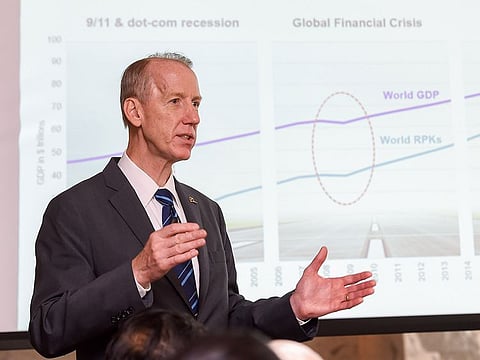Middle East airlines well placed for growth as other markets play catch-up: Boeing
Middle East airlines will need 2,980 new planes in 20 years to serve demand, says Boeing

Dubai: The global aviation market has plenty of room to grow, and governments in the Middle East are well primed to take advantage and further consolidate their lead, a senior Boeing official said on Monday.
While the COVID pandemic and subsequent inflation have somewhat dampened the overall market, airlines in the Gulf have weathered the storm better than others, said Randy Heisey, Boeing’s managing director of Commercial Marketing for the Middle East and Africa, and Russia and Central Asia Regions.
“The Middle East region, a popular connection point for international travelers and trade, is also growing as a starting point and destination for business and leisure passengers,” said Heisey. “The region will continue to require a versatile fleet that meets the demands of airline and air-cargo business models.”
And Boeing is planning to take advantage of this anticipated spike.
Middle East airlines will require 2,980 new airplanes valued at $765 billion to serve passengers and trade, the plane maker said as it revealed its 20-year demand forecast for the region.
Bulk of the demand will be fulfilled by single-aisle planes, at 1,580, while wide-body aircraft demand is projected at 1,290 during this two-decade period.
Of these, over two-thirds of the deliveries will enable growth, while one-third will replace older airplanes, the US-based plane manufacturer said.
A growth market
Over the next 20 years, airline traffic growth in the Middle East is projected to increase by an average of 4 per cent per year, compared to the global growth of 3.8 per cent per year, Boeing said.
“Traffic (for Middle East carriers) will multiply 2.4 times over the next 20 years, with airlines rapidly growing their origin and destination passengers and serving as key hubs for inter-region connecting passengers,” Heisey said.
Higher ground
Heisey highlighted that while the global economy’s growth projections have been dampened with high hydrocarbon costs, commodity prices and inflation, oil-exporting economies in the Middle East have benefited, and this would be the right time to invest into fleet expansion while other markets, especially Europe, struggle to get back on their feet.
Of the overall fleet availability, Middle East airlines have pushed 93 per cent aircraft back into service, compared to 92 per cent globally, Boeing said. Airlines in the region are also operating more flights (91 per cent) compared to the global average (83 per cent), when compared to 2019 levels.
Middle East airlines have performed exceptionally well in terms of short-haul flights, and are back to 98 per cent of 2019 levels, compared to a global average of 81 per cent. In terms of long-haul routes, regional airlines are at 76 per cent of 2019 levels, two percentage points above the global average.
“Gulf airlines have been quick to open up new routes and serve within shorter radii as countries open up for travel. These are countries where rules were relaxed faster compared to others. It’s also important to note that different governments have followed different protocol when opening up their skies,” Heisey pointed out.
Freight impact
When the pandemic struck and passengers stopped flying, it also wiped out the belly-hold cargo capacity in passenger planes.
“Dedicated freighter ATKs (available tonne kilometres, a way of measuring an airline’s transportation capacity) are now ahead of their 2019 levels, while belly capacity is still down by one-third,” the official said.
However, as of June 2022, Middle East cargo traffic has nearly recovered to pre-pandemic levels, at 98 per cent of 2019 levels, compared to 97 per cent globally.
At the lower end of the chart are Europe (85 per cent) and Asia & Oceania (93 per cent).
“Middle East carriers such as Emirates have done well to have dedicated freighters that have kept revenue flowing. Now is the chance to further increase this margin and further consolidate the lead,” the Boeing official said.
Two of the world’s top five cargo carriers by tonnage are based in the region. To serve future demand, the Middle East freighter fleet is projected to reach 170 by 2041, more than doubling the pre-pandemic fleet, Boeing projected.
Emirates was ranked No 2 globally in 2021 in terms of FTKs (freight tonne kilometres), up from No 5 in 2011. One FTK is one metric tonne of revenue load carried one kilometre.
Replacement of aging airplanes, plus those needed for growth, will create a demand for 2,795 freighter deliveries in the next 20 years, Boeing added.
Other takeaways
> Middle East airlines will require 2,980 new airplanes in the next 20 years, valued $765 billion, 43% of which are forecasted to be widebody passenger jets
> In the widebody segment, Boeing forecasts a regional demand for 1,290 new passenger airplanes by 2041.
> Single-aisle airplanes will continue to be the largest market segment with operators projected to need 1,580 new airplanes in the next 20 years.
> Air cargo demand is expected to grow 8 per cent by 2041. The Middle East freighter fleet is expected to reach 170 aircraft of which 70 will be new deliveries.
> The region is estimated to require 202,000 new aviation personnel in the next 20 years, including 53,000 pilots, 50,000 technicians, and, 99,000 cabin crew members.
Sign up for the Daily Briefing
Get the latest news and updates straight to your inbox



